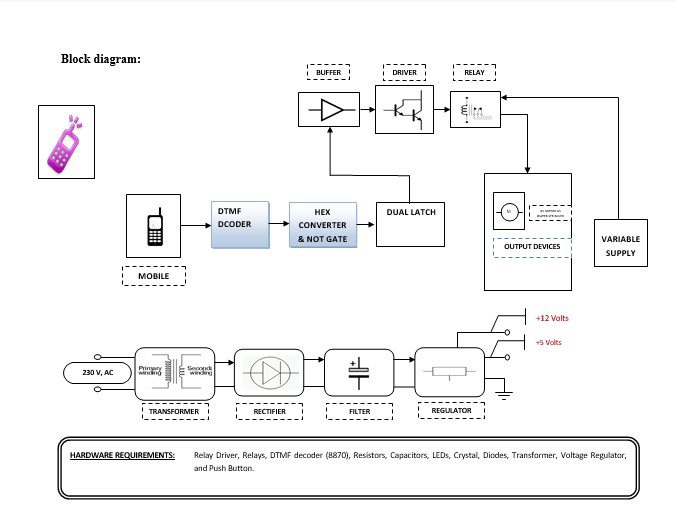Table of Contents
Introduction:


This Project is a very good example of an embedded system as all its operations are controlled by intelligent software inside the microcontroller. GSM-based designs have developed another innovative and public utility product for mass communication. This is a DC Motor Control Device that controls messages received as SMS and also sends an acknowledgment of the task. These devices are designed to remotely control the DC Motor from anywhere and anytime. This remote control DC motor control device is possible through embedded systems. The main aim of the project is to design an SMS electronic DC Motor Control Device. The toolkit receives the SMS, validates the sending Mobile Identification Number (MIN), and performs the desired operation after necessary code conversion. The system is made efficient by SIMs so that the SMS can be received by several device boards in a locality using techniques of time division multiple access. With this in mind, we have designed the project to work with sim300 technology.
The speed of the motor is measured using the contactless speed measurement technique. Speed control is done using PWM (Pulse Width Modulation) method. Users can send SMS messages to control the motor speed and direction. A GSM modem attached to the control unit handles the automatic SMS sending and receiving process. As this monitoring and controlling can be done by any mobile phone, we provided a security feature by implementing password-based protection. The user has to send the password along with the commands to be controlled.


Block diagram explanation :
Power supply unit:
This section needs two voltages viz., +12 V & +5 V, as working voltages. Hence specially designed power supply is constructed to get regulated power supplies.
Buffers:
Buffers do not affect the logical state of a digital signal (i.e. a logic 1 input results in a logic 1 output whereas logic 0 input results in a logic 0 output). Buffers are normally used to provide extra current drive at the output but can also be used to regularize the logic present at an interface.
Drivers:
This section is used to drive the relay where the output is the complement of input which is applied to the drive but the current will be amplified.
Relays:
It is an electromagnetic device that is used to drive the load connected across the relay and the o/p of the relay can be connected to the controller or load for further processing.
Indicator:
This stage provides a visual indication of which relay is actuated and deactivated, by glowing respective LED or Buzzer.
DTMF Decoder:
The DTMF decoder used is CM8870. It is used to decode the mobile’s audio signal, i.e., the keypad tone. When the user presses a button on the keypad of the mobile, it generates two tones at the same time. These tones are taken from a table comprising a row frequency and a column frequency. Thus the resulting frequency signal is known as the “Dual Tone Multi-Frequency” signal. A DTMF signal is an algebraic sum of two different frequencies, one from the row frequency (higher frequency) group and another from the low frequency (column frequency) group. The CM8870 decodes the received DTMF tone and then sends its equivalent binary code to the microcontroller. According to the program loaded into the microcontroller, the corresponding action starts.
Methodology:
This process works when a mobile phone initiates a call for the other mobile phone on any network which is connected with the receiver end in auto answer mode. During this outgoing call if a key is pressed the associated key generates dual tone multiple frequency (DTMF) at the other end. The received tone is processed by DTMF decoder IC MT8870. A specific frequency consisting of two separate tones is assigned by the DTMF decoder. It produces two different frequencies from lower band and upper band frequencies. For example, if the user presses the key„2‟ it will send a tone comprising 697 Hz and 1336 Hz to the other end of the system. Then the decoder produces an equivalent binary digit after decoding the DTMF tone [5]. This binary number goes to relay driver IC ULN2003, which drives the relays and produces the output for the DC motor. Crucial components used in this project are the DTMF decoder (MT8870), Relay driver (ULN2003), and Voltage regulator (7805). When mobile headphone output is connected to pin 2 (IN-) in a single-ended input configuration it is recognized to be effective, a correct 4-bit decoded signal corresponding to the DTMF tone is transferred to pin 11 (Q1) – pin 14 (Q4) outputs. Q1-Q4 pins of the DTMF decoder are connected to input pins (1 B – 4 B) of relay driver IC ULN2003 respectively. Pin 1 (IN+) and pin 4 (Vref ) of the DTMF decoder. IC MT8870 is shorted. Binary output from MT8870 is not sufficient for operating the relays directly since the magnitude of output current is very low. Thus, the authors have used ULN2003 for current amplification purposes. A 3.597 MHz crystal oscillator is used for providing clock input to MT8870. The output from the Voltage regulator (7805) i.e. 5 V is given to MT8870.
Advantages:
- The circuit is cost-efficient as well as simple to operate.
- All the components required are easily available.
Disadvantages:
If GSM fails to catch the network then failure of controlling the devices.
Applications:
- Used for controlling the speed of DC motors in industries.
- It can be used to control the speed of the DC motor in servo stabilizers.




